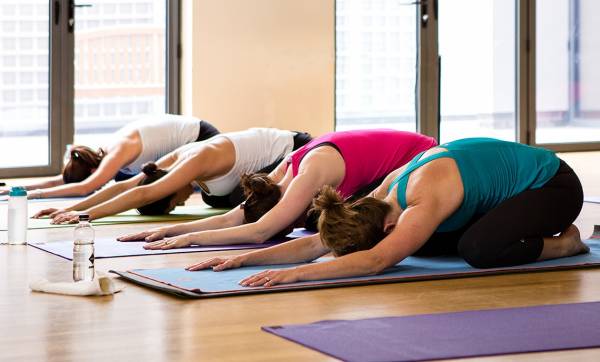If Webster and the Merriams were yogis, they’d proclaim that alignment is “the state of being arranged in a line or proper position.” And the millions of yoga practitioners would emphatically nod their heads and agree.
These yogis would also agree alignment is a cornerstone to the practice of yoga. But when asked about the specific line or proper position of a pose (let’s say triangle pose or warrior one), pandemonium over specifics would ensue.
RELATED: The Butt of a Backbend: A Lesson in Gluteal Anatomy
Triangle Pose
If alignment is so important to the practice of yoga asana and we are all doing the same asanas, why do we disagree? Is the disagreement valid or is there truly one right way to bend and move? And, if there is more than one right way, how can an individual find his or her own lines on the mat?
We Have to Start Somewhere
Before we learn to run, we learn to walk. Before we write in cursive, we learn to print. And when we learn to print, we start with instructions for a series of exact lines and shapes drawn between dotted lines. At first, we’re not great at it. Our lines are shaky and our curves are lumpy.
RELATED: It’s Called Yoga “Practice” for a Reason
So, we practice until we can make legible letters without guiding lines. It’s part of the deal. If we were given paper and a pen, we wouldn’t write letters, we’d draw pictures. We need the lines. We color inside the lines. Then, when we’ve mastered that, we can successfully take a more artistic approach.
“In a public class, the teacher has to teach to the average, and he or she absolutely has to give some guidelines. It makes sense that classes are this way, but the lines aren’t posture perfect for everyone, just like everyone isn’t exactly average.”
Yoga is the same. We have to learn the basics. Put your foot here. Put your hand here. Look up. Without these boundaries, we wouldn’t have anything to press against or to work toward. Also, without these alignment standards, most of us wouldn’t have access to yoga because we’d have to practice one-on-one with a teacher or alone with a resource to get instruction.
In a public class, the teacher has to teach to the average, and he or she absolutely has to give some guidelines. (Imagine having no idea what you’re doing and hearing, “Do what feels right to you.”) It makes sense that classes are this way, but the lines aren’t posture perfect for everyone, just like everyone isn’t exactly average.

Boundaries Help Us Learn Ourselves
Different yoga systems put different emphasis on how to place the body in space. Different teachers put different interpretations on different systems. Some systems and teachers are more rigid than others. In a way, the systems and the teachers (myself included) are all right and wrong.
READ: Arm Balancing: Improve Your Strength Through Alignment
While some are mechanically better than others, no alignment principle will ever be foolproof. All the proof you need to know that is to know no two bodies are exactly the same.
I see this all the time in yoga foot alignment. Everyone is told to make the feet line up in a parallel way. But if you look up from their feet, up to the knees, half the people in the room will have knees that clearly look uncomfortable. Why?
“The boundaries of alignment have a place in helping us to learn how we already operate in space and they give us a direction for future movement.”
Well, perhaps they are pigeon-toed, bow-legged, or have one foot that turns out more than the other (women carrying kids or those who drive with a leg on the dash are often candidates for this). However, the ankle bone is still connected to the knee bone, so one change creates another and that change might not be suitable.
The “Right” Shape vs. Your Own Shape
So, if I’m bow-legged and make my feet parallel in yoga, everything will feel better, right? Wrong. Okay, so, if I’m bow-legged and just do what I feel like, my legs will not bow out more over time. Also, wrong.
So, what gives?
“In sum, the alignment guidelines can help us to prevent natural deterioration of the joints due to habit or genetics if we move slowly in the direction of them without forcing our body into a line.”
The boundaries of alignment have a place in helping us to learn how we already operate in space and they give us a direction for future movement. In this example, moving the feet a tiny bit away from bowing, but not so parallel to experience joint pain, would be a happy medium.
READ: Lessons from Katy Bowman in How to Hold Your Own Weight
In sum, the alignment guidelines can help us to prevent natural deterioration of the joints due to habit or genetics if we move slowly in the direction of them without forcing our body into a line.

Things Are Always Going to Change – Always
This is one of the toughest and most interesting things about teaching and doing yoga: nothing is static. We love routine. Our bodies gravitate towards habits. Change is hard and yet it is always happening. We all need to stay one step ahead of ourselves.
As a young yogi, every time the teacher said, “Tuck your tail,” or, “Shoulders down,” I obeyed. At the time, I wanted to be a perfect yogi. I went so far that I had no more butt and my shoulders lived behind me. The cues weren’t wrong. They just didn’t apply to me anymore.
“Alignment principles certainly aren’t perfect. And rules are made to be broken. In yoga, we need the cues to make the shape to get the idea to feel the effect.”
When I figured that out, I was mad at the teacher, but later I realized part of it was about me. I was only listening to her, and not to myself, which is arguably the whole point of practice. Practice isn’t perfect. It’s practice.
The State of the State of Being Arranged in a Precise Way
This leaves us in a grey area, not a place I personally like to be. But if we look historically, it was a comfortable spot for the greats. Tirumalai Krishnamacharya taught a half a dozen modern-day yoga teachers who taught systems of yoga that didn’t always align. Clearly, he was comfortable with change and with differences. He understood things change and he didn’t have to teach to the average, as big public classes weren’t a thing then.
CHANGE IS GOOD: Seasons of the Athlete: Evolving With Change
Alignment principles certainly aren’t perfect. And rules are made to be broken. In yoga, we need the cues to make the shape to get the idea to feel the effect. The teacher helps us with that. Then, we combine that with our internal knowledge about our own, very different bodies. We need awareness for that.
So the next time you decide to line up in proper position, consider the middle – the spot somewhere between coloring in the lines and signing your own name to the bottom of the page.
Photos 2 and 3 courtesy of Savannah Wishart.






